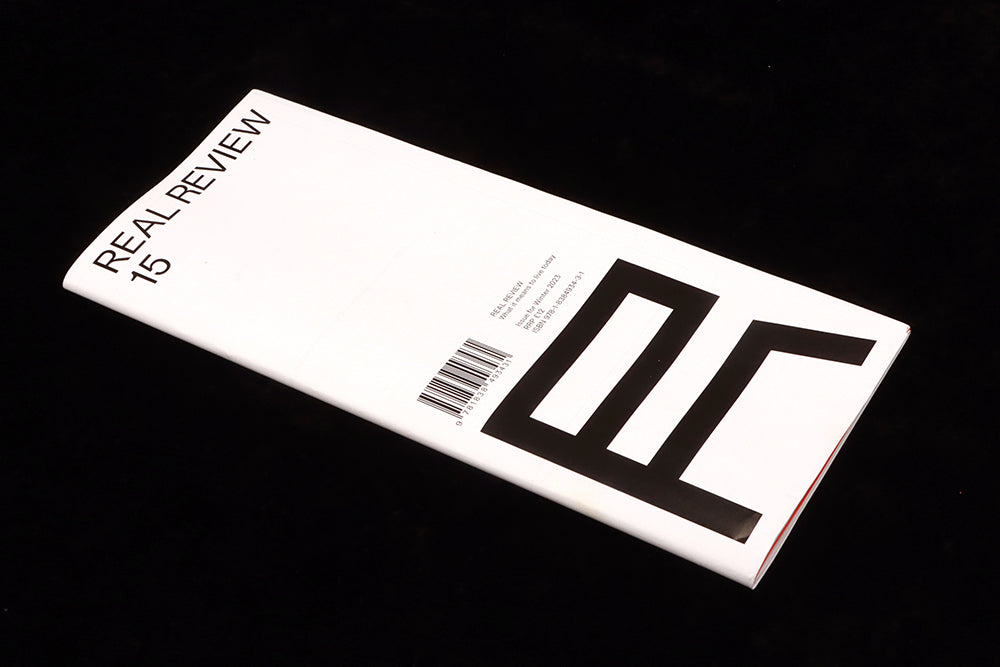
Real Review #15
The latest Real Review challenges the expectations of its readers by deleting all images from the issue to protest the lack of proper media coverage of the suffering in Gaza. We spoke to founder Jack Self to find out more.
We last heard from Jack in 2019, when he talked us through the cover designs of the first eight issues of Real Review. The covers have followed the same template since—leading with an orange and black face (or faces) drawn by artist Nishant Choksi to reflect the theme of each issue. Yet the current 15th issue has dropped even that image, leaving a ghostly space on the front cover.

‘Every issue of Real Review attempts to capture some feeling of what it means to live today—we call this the “current mood”, and the for this issue is ‘Phantom of Liberty’, Self explains.
‘This mood stems from observations on absurdity: the absurd can occur when suffering becomes so extreme it flips into disbelief and humour; it can also occur when social reality and material reality become separated. For example, we recognise a policeman as an agent of the rule of law. But if you look at him for too long, you just see a man in a silly costume—at which point this material reality trumps the social construct, and the abstract concepts of “rule of law” or “justice for all” disappear.’
‘The scale of violence inflicted on the Palestinians by the IDF at the moment is so great, and the suffering so extreme, and the inaction from the West so deafening, that this event has called into question the purpose of the nation state. It has revealed the awesome brutality of Western colonialism, the total impotence of our leaders and the moral bankruptcy of the so-called “International Order”.
‘The Phantom of Liberty was an absurdist film shot by Luis Bunuel in the 1970s, which combines humour with extreme violence. It aligns with the sensation at the moment that whatever freedoms remained—in Western democracies, but globally—are somehow evaporating.

‘The absence of imagery was a product of our interview with writer Shumon Basar (above). We imagined running imagery from Gaza, but I personally felt these were so disturbing and so traumatic, I didn’t see how I could reprint such deplorable scenes of inhumanity. Then I remembered that Alfred Hitchcock once said that to show violence is sometimes less powerful than to imply it and let the audience use their imagination. So we replaced the images with “alt” text—the accessibility text descriptions used when an image online fails to load.

‘This led to an idea that perhaps we should remove all imagery. In some sense it was probably motivated by a desire to not look at images right now. But the effect is to reveal the essential structure of Real Review. What you see is a wireframe for how to make the magazine; the communication of this issue is the logic of the design itself.’

Jack and art director Colin Doerffler had already commissioned the issue’s cover face from Choksi. ‘Before October 7 the mood was heading in a different direction. We are all pessimistic, but somehow hopeful: we know there is very little rational reason to feel that the quality of our daily and collective lives will improve over the next few years. Yet we remain hopeful; that something unexpected will occur, that something will happen that shifts the entire trajectory of society. We commissioned Nishant Choksi in relation to this mood. But once Phantom of Liberty came to the fore, we took the decision to drop the face entirely. It is a ghost face, it is a spectre of freedom.’

The resulting cover is empty yet powerful. An initial reaction is to see it as a mistake, a printing error, yet it’s a sign of the strength and familiarity of the magazine’s cover template that the face is immediately missed. Was Jack surprised how such an absence could be so powerful?

‘Real Review is an experiment in the possibility of non-commercial culture. We have no adverts, no benefactors, no commercial partnerships, no external funding of any kind. It only exists by the grace of a dedicated community. Because of this, Real Review has much greater freedom than most publications—it can take far greater risks, it can experiment, it can play.
‘The ability to make a move of this kind—to remove a key element, and indeed to remove all imagery—is quite risky. Many people could be disappointed, indeed many of the artists whose images were to be included were definitely disappointed. But at the same time, I do feel very strongly we must create a space for following a particular logic to its natural conclusion, whatever that means for the aesthetic of the magazine. I guess to be more brief: it was a surprise even for me.’
That seems to me the very definition of an independent magazine—if you can’t afford risk in your own magaizne, when can you? The imageless cover is a vital addition to the Real Review series, and as well as protesting a point reminds us every issue of any magazine is a reaction to previous issues.
The issue also draws attention to the general lack of attention from the indie sector to the situation in Gaza.
The colophon at the back of the issue reserves the right to republish the issue with all images intact, ‘In the event that the possibility of liberty solidifies beyond its phantom form, Real Review may reprint or make available this issue with complete visual material’. Let‘s hope we get to that point some time soon.


